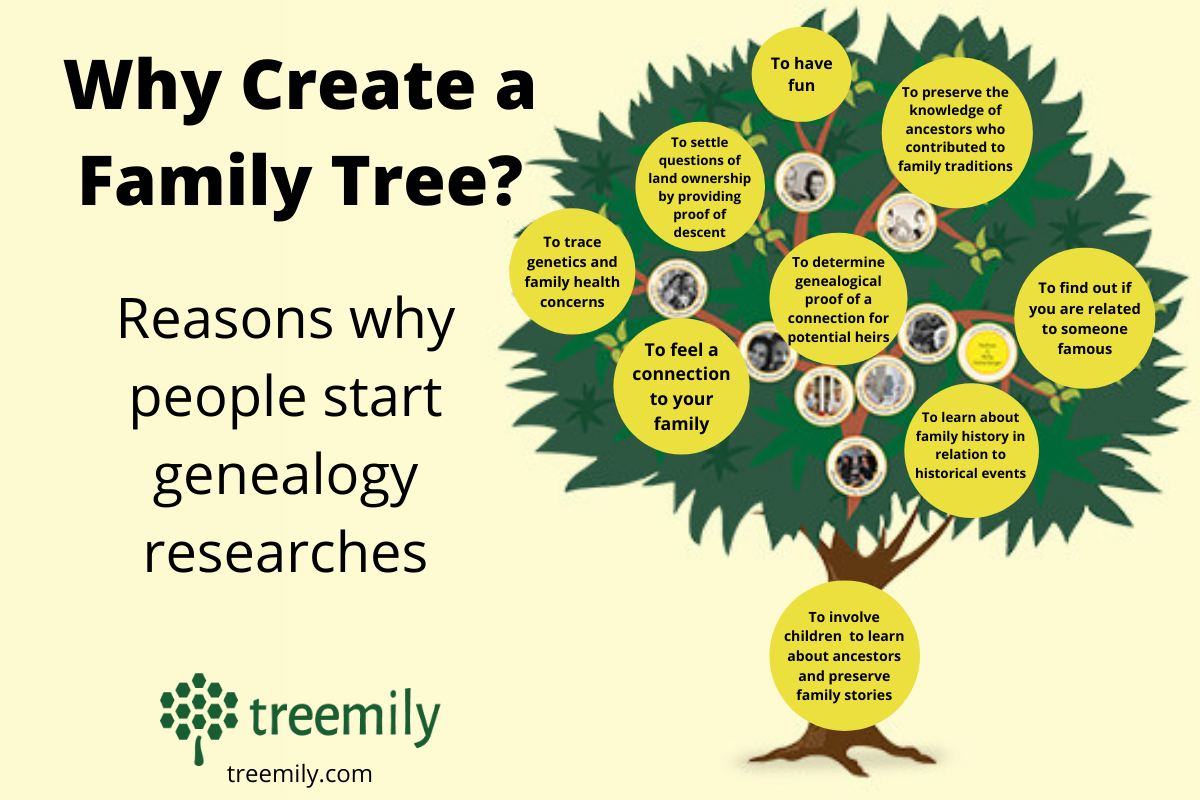Your family history research is always based on an effective organization. Just like with anything else in life, setting the right expectations and organizing processes goes a long way in achieving your goals.
In this article, we will give you 7 crucial tips to successfully conduct genealogical research along with 7 Mistakes to Avoid When Researching a Family Tree.
What Is a Family Tree?
A family tree is a visual representation of your lineage that traces relationships to your ancestors. It is visually similar to an organizational chart and is usually represented in a tree structure starting with the oldest known ancestor as the root. From the root, the tree branches terminate in boxes representing leaves. Each leaf represents a family member with information about them, such as birth, marriage, and death dates.
Infographic: Why Create a Family Tree?
The practice of genealogy, researching one’s ancestors, has exploded lately. Many, if not most, families in the United States have at least one family member actively researching their family history, not to mention professional genealogists who do genealogy as a job.
There are many reasons why people start genealogy research:
How to Design a Family Tree
- Define Your Family Size
- Decide on Who to Include in Your Family Tree Layout
- Older Records Require More Effort
- There Might Be Someone Talking About Your Ancestors
- Question All Sources
- Use Treemily to Create Your Family Tree
- Learn to Enjoy the Process
1. Define Your Family Size
The time you will have to spend on a family tree design will largely depend on the size of your family. People often underestimate their family size since they forget to take their extended family into consideration. Besides brothers, sisters, uncles, and aunts we also have distant relatives that we shouldn’t forget about.
With more in-depth research, it is possible to trace your family history back about 150 years, which is about 5 generations. Basically, this will be the scope of your family tree. So, how to calculate the approximate amount of family members in a tree of five generations?
A typical family tree will include 2 parents, 4 grandparents, and 8 great-grandparents. If you keep counting backward you will discover you have 32 great-great-great-grandparents. Considering that probably your ancestors had brothers and sisters, this number multiplies. Could you imagine your family tree is that big?
2. Decide on Who to Include in Your Family Tree Layout
Logically, with such a big number of family members there comes another question: “How to cope with all the data?” Be selective in your research. You can take only one branch of your tree or you can go sideways and record all family members who are still alive today. The approach will depend on your family structure and the resources you have at your disposal. The more records about your ancestors there are, the easier it will be to track your family roots.
You can start tracing your family tree horizontally and vertically at the same time. Just choose what branches of your tree you want to do first. The easiest way is, to begin with, the branches where it is faster to get the data you need.
3. Older Records Require More Effort
As a rule, the older the documents you are looking for are, the more time, skill, and resources it takes to collect the information.
Learning about your distant ancestors can seem an exciting journey. However, the amount of effort it takes to obtain information about just one person can equal the amount of effort it takes to collect data about several living relatives. Sit tight – in the beginning, it may be frustrating but after you gain some experience it will come off easily.
4. There Might Be Someone Talking About Your Ancestors
Searching for old records can be difficult. Provided that typewriters didn’t become common until the mid-1880s so most government records before this time were handwritten, and quite often not standardized. Searching for such information is time-consuming and expensive.
Check out if someone has already done the research for you. There might be families who had already published their family trees in a book format. There might be some local history books describing families that live in your area. In the age of the internet, it becomes much easier to find someone mentioning your family.
Society of Genealogists is one of the most popular websites that contain published and unpublished family histories notes. However, be careful with copying data as it might not be verified. Make sure every piece of information you copy is backed by a source document.
5. Question All Sources
There are many sources nowadays that provide family trees created by other people. However, some of them may be questionable. Don’t assume that everyone is diligent when conducting research. Someone can be just making educated guesses.
Doing research may be tiring and you may want to cut corners but this is not a rational approach. It may not be obvious when someone makes guesses, so you need to verify all the facts you find on the internet.
6. Use Treemily to Create Your Family Tree
Our family tree maker will help you visualize your family history and share your ancestors’ stories with your loved ones. You can choose various templates and play with colors to make your tree look the way you see it.
The truest form of art is the one that touches your heart. So creating an artistic interpretation of your history through a family tree is a great way to feel connected to something much bigger than yourself.
7. Learn to Enjoy the Process
There is always more to discover. To be successful in your genealogical research you need to treat it like a lifetime hobby. In some way, a family tree cannot be really finished because it is a living reflection of your family and your family is constantly changing. There might be moments when you will feel tired and ready to give up. Just put down your research for some time.
Though don’t neglect to make notes of your previous discoveries. None of us has a perfect memory, so some facts may be lost if you don’t document them. Otherwise, you will have to repeat the work you have previously done.
7 Mistakes to Avoid When Researching a Family Tree
Alternate Spellings and Spelling Errors

Seemingly dead ends as you research your family history are caused by simple spelling mistakes and inconsistencies much more often than you might think. As documents age, we instinctively become more trusting of their contents. They have, after all, stood the test of time, haven’t they? But bear in mind that any resources you are relying on may include errors. A simple difference in the spelling of a name can open up new avenues in your investigation. Just the name Hailey, for example, could be spelt Hailee, Haleigh, Haley, Haylee, Hayleigh, Hayley, or Haylie. Keep an open mind in the course of your research.
Incorrect Data Copied from Family Trees
The Internet is teeming with genealogy resources. There is no shortage of family tree websites to help you along as you build your own. Once you find a related family tree, it is tempting to not reinvent the wheel and simply build on the work that’s already been done. You save yourself a lot of time and effort, and open up a whole new realm of possibilities with the new clues you get. But before you plow ahead with your newfound knowledge, make sure you do your due diligence and vet it first. It is more than likely that there are mistakes and incorrect information. Check the sources of the information in the family tree and verify that the connections are well-founded before you develop your research in that direction. The sooner you uncover any errors, the fewer the number of steps you have to retrace in your work to correct them.
Failing to Consult your Elders

The convenience that we’ve grown accustomed to makes it tempting to use the Internet to research almost anything. Genealogy records offer literally billions of records to search through. However, there simply is no substitute for firsthand information. Start with the people in your family. Grandparents, aunts, uncles, and cousins will all give you a wealth of information that is easily verifiable, and has some foundation and isn’t just hit or miss, like Internet searches. It takes more time and requires more work, but the results make the effort worthwhile.
Same Name, Different People

Confusion with names can wreak havoc with your search. Incorrectly assuming a relative’s namesake is in fact your relative can have you headed in the wrong direction, exploring the stories of people who are not your relatives. There is also the risk of missing an entire generation by not paying close enough attention to sons who share names with their fathers. Reduce the risks of falling into these traps by thoroughly checking dates, and verifying the sources of information.
Merging Records Incorrectly

You may have done a significant amount of work putting your family tree together before stumbling upon the opportunity to merge it, or some parts of it, with information you find on a site like Ancestry. The temptation to instantly grow your family tree should be resisted, and instead, ensure you check the information that you are copying over. It might turn out that there are mistakes in the new information, or it doesn’t contain as much data as what you have put together. Check to make sure you don’t overwrite well-researched, accurate information.
Not Documenting Your Sources
Your family research will ideally not end with you. Future generations, or other contemporary members of your family may want to continue to build upon your research. You should therefore ensure you make it easy for them to verify the information you have by providing sources as much as possible. Your family tree will not only have reliable information, you improve the likelihood that others will carry on the tradition with the same high standard.
Failing to Read the Entire Genealogy Record
A lot of the work of a genealogy sleuth makes for slow, tedious going. The impulse to cut corners and stop once you’ve found the connection you are looking for can be hard to put down. Go the extra mile and ensure you faithfully chase down all the facts, even the seemingly mundane ones. You never know where they might lead.
Successful genealogists are those who go slow and don’t expect to find all information at once and conveniently packaged. By following these tips you can avoid some of the common mistakes people make while creating their family trees. Don’t forget to make a family tree using the Treemily family tree maker online to keep the memory of your loved ones for the next generations.













